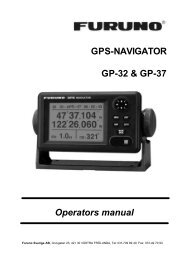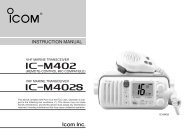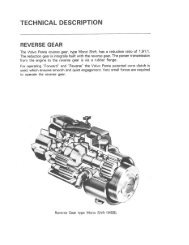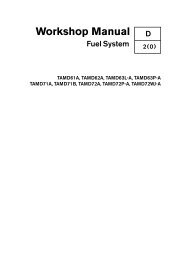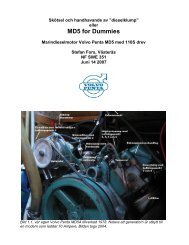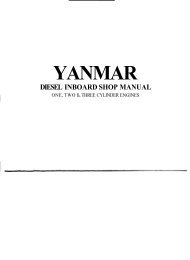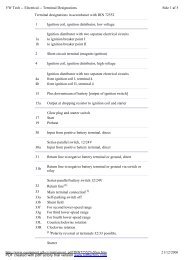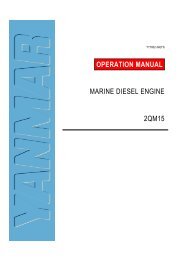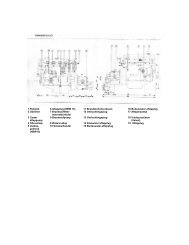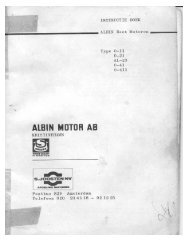AutoHelm ST 2000 Plus - Comcast.net
AutoHelm ST 2000 Plus - Comcast.net
AutoHelm ST 2000 Plus - Comcast.net
- No tags were found...
You also want an ePaper? Increase the reach of your titles
YUMPU automatically turns print PDFs into web optimized ePapers that Google loves.
<strong>ST</strong>1000 <strong>Plus</strong> &<strong>ST</strong><strong>2000</strong> <strong>Plus</strong>Tiller PilotsOwner’sHandbookDocument number: 81130-3Date: June 2001
ii<strong>ST</strong>1000 <strong>Plus</strong> & <strong>ST</strong><strong>2000</strong> <strong>Plus</strong> Tiller Pilots - Owner’s HandbookAutohelm, HSB (High Speed Bus), SailPilot, SeaTalk and SportPilotare registered trademarks of Raymarine Ltd.Raymarine, A<strong>ST</strong> (Advanced Steering Technology), AutoAdapt,AutoLearn, AutoRelease, AutoSeastate, AutoTack, AutoTrim,FastTrim, Gyro<strong>Plus</strong>, RayGyro, RayPilot and WindTrim aretrademarks of Raymarine Ltd.Handbook contents © Raymarine Ltd 2001.
PrefaceiiiContentsChapter 1: Introduction ............................................................11.1 Overview .................................................................................. 11.2 Specifications ............................................................................ 21.3 About this handbook ................................................................. 3Important Information .............................................................. 3Chapter 2: Using the Tiller Pilot ...............................................72.1 Overview .................................................................................. 72.2 Using Auto mode ...................................................................... 8Engaging the autopilot (Auto mode) ......................................... 8Disengaging the autopilot (Standby mode) .............................. 8Changing course ....................................................................... 9Displaying navigation information pages ............................... 12Automatic deadband control (Auto Seastate) ......................... 12Operating hints – trim changes ............................................... 132.3 Switching display illumination on and off .............................. 142.4 Using Track mode ................................................................... 15Selecting Track mode ............................................................. 15Returning to Auto from Track mode ....................................... 17Cross track error (XTE) .......................................................... 17Tidal stream compensation ..................................................... 18Waypoint arrival and advance ................................................. 19Dodges in Track mode ............................................................ 19Safety in Track mode .............................................................. 20Warning messages in Track mode ........................................... 212.5 Using WindTrim mode ........................................................... 23Selecting WindTrim mode ...................................................... 23Exiting WindTrim mode ......................................................... 24Returning to the previous apparent wind angle ....................... 24Wind shift alarm ...................................................................... 24Operating hints for WindTrim mode ....................................... 25Chapter 3: Maintenance & Fault Finding ..............................273.1 General maintenance .............................................................. 273.2 Product support ....................................................................... 283.3 Fault finding ............................................................................ 28Chapter 4: Installing the Tiller Pilot ......................................334.1 Planning the installation .......................................................... 334.2 Installing the tiller pin and mounting socket ........................... 36Measuring the critical dimensions .......................................... 36
iv<strong>ST</strong>1000 <strong>Plus</strong> & <strong>ST</strong><strong>2000</strong> <strong>Plus</strong> Tiller Pilots - Owner’s HandbookBasic installation ..................................................................... 37Installation accessories ........................................................... 384.3 Cabling and socket installation ............................................... 45Mounting the socket ............................................................... 45Power supply .......................................................................... 46SeaTalk cabling ....................................................................... 47NMEA cabling ........................................................................ 49Connecting NMEA and SeaTalk ............................................ 50Chapter 5: Commissioning the Tiller Pilot ...........................515.1 Functional tests ....................................................................... 51Switch on ................................................................................ 51Operating sense ....................................................................... 51Checking the navigation interface .......................................... 52Checking the wind instrument interface ................................. 54Checking the SeaTalk interface .............................................. 545.2 Initial sea trial .......................................................................... 55Calibrating the compass .......................................................... 56Autopilot operation ................................................................. 585.3 Adjusting autopilot performance ............................................ 58Chapter 6: Adjusting Tiller Pilot Settings ............................616.1 Introduction ............................................................................ 61Adjusting calibration values ................................................... 61Calibration features ................................................................. 63Default calibration values ....................................................... 636.2 Calibrating the tiller pilot ........................................................ 64Calibration Level 1: Rudder gain ............................................ 64Calibration Level 5: cruise speed ............................................ 64Calibration Level 6: off course alarm angle ............................ 64Calibration Level 9: mag<strong>net</strong>ic variation ................................. 65Calibration Level 10: heading error correction ....................... 65Calibration Level 11: boat’s current latitude ........................... 66Calibration Level 13: rudder damping .................................... 66Controlling access to calibration ............................................. 66Index ..................................................................................... 69
Chapter 1: Introduction 1Chapter 1: Introduction1.1 Overview1 IntroductionD5557-2Your Raymarine tiller pilot is a totally self-contained autopilotdesigned for tiller steered sailboats. The autopilot is mountedbetween the tiller and a single attachment point on the boat’sstructure. It is designed for owner installation and is ready for useafter connection to the boat’s 12 V electrical system.Operating modesThe tiller pilot has four basic operating modes:• Standby mode: autopilot off• Auto mode: autopilot engaged and locked onto a heading• Track mode: autopilot on and maintaining a track between twowaypoints created on a navigation system• WindTrim mode: autopilot on and maintaining a course relativeto an apparent wind angleSeaTalk and NMEA compatibilityThe tiller pilot is SeaTalk compatible, so it can share data transmittedfrom other Raymarine SeaTalk instruments:• wind information from a wind instrument can be used forwind vane steering without the need to install a separate vane• track information, from a navigator, enables the autopilot toprovide waypoint control• boat speed from a speed instrument can provide optimum trackkeeping performance• SeaTalk compatibility also allows additional fixed and hand-heldautopilot control units to be easily connected at secondarysteering and control positions
2 <strong>ST</strong>1000 <strong>Plus</strong> & <strong>ST</strong><strong>2000</strong> <strong>Plus</strong> Tiller Pilots - Owner’s Handbook1 Introduction1.2 SpecificationsThe <strong>ST</strong>1000 <strong>Plus</strong> and <strong>ST</strong><strong>2000</strong> <strong>Plus</strong> tiller pilots can also be used withany navigator transmitting NMEA 0183 or NMEA 0180 data.The tiller pilot can be calibrated to suit each installation to providemaximum performance with many types of boat.General specificationsPower supply:Drive unit thrust torque:Maximum boatdisplacement:Drive mechanism:Helm speed (lock to lock):Current consumption:Operating temperature:Main features:10 V to 15 V DC<strong>ST</strong>1000 <strong>Plus</strong>: 57 kg (125 lb)<strong>ST</strong><strong>2000</strong> <strong>Plus</strong>: 77 kg (170 lb)<strong>ST</strong>1000 <strong>Plus</strong>: 3 000 kg (6 600 lb)<strong>ST</strong><strong>2000</strong> <strong>Plus</strong>: 4 500 kg (10 000 lb)<strong>ST</strong>1000 <strong>Plus</strong>: lead-screw and nut drive<strong>ST</strong><strong>2000</strong> <strong>Plus</strong>: re-circulating ball drive<strong>ST</strong>1000 <strong>Plus</strong>: 8 seconds<strong>ST</strong><strong>2000</strong> <strong>Plus</strong>: 4.5 seconds• Standby: 40 mA (90 mA with full lighting)• Auto: 0.5 A to 1.5 A depending on boat trim,helm load and sailing conditions0°C to +70°C (32°F to 158°F)• 6 button digital keypad• Backlit LCD display of heading, locked courseand navigational information• User calibration for optimum performance• WindTrim control in WindTrim mode• SeaTalk compatible• Automatic compass deviation correction• Northerly/Southerly heading compensation• Automatic heading deadband – seastate control• Automatic tack• Built-in navigator interface (NMEA and SeaTalk)• Waypoint advance featureEMC conformanceAll Raymarine equipment and accessories are designed to the bestindustry standards for use in the recreational marine environment.The design and manufacture of Raymarine equipment andaccessories conform to the appropriate Electromag<strong>net</strong>icCompatibility (EMC) standards, but correct installation is required toensure that performance is not compromised.
Chapter 1: Introduction 31.3 About this handbookPart 1: Using the Tiller PilotThis part of the handbook explains how to use your tiller pilot:2Chapter 2: Using the Tiller PilotHow to use the tiller pilot.page 71 Introduction3Chapter 3: Maintenance & Fault FindingProvides maintenance and fault finding information.page 27Part 2: Installing the Tiller PilotThis part of the handbook explains how to install your tiller pilot:456Chapter 4: Installing the Tiller PilotHow to install your tiller pilot and its components.Chapter 5: Commissioning the Tiller PilotHow to check the tiller pilot and perform an initial sea trial.Chapter 6: Adjusting Tiller Pilot SettingsHow to change the tiller pilot calibration settings.page 33page 51page 61Note: This handbook contains important information aboutinstalling, using and maintaining your new Raymarine product. Toget the best from the product, please read this handbook thoroughly.Important InformationWarrantyTo register your new Raymarine product, please take a few minutes tofill out the warranty card. It is important that you complete the ownerinformation and return the card to us to receive full warranty benefits.Handbook informationTo the best of our knowledge, the information in this handbook wascorrect when it went to press. However, Raymarine cannot acceptliability for any inaccuracies or omissions it may contain. In addition,our policy of continuous product improvement may changespecifications without notice. As a result, Raymarine cannot acceptliability for any differences between the product and the handbook.
4 <strong>ST</strong>1000 <strong>Plus</strong> & <strong>ST</strong><strong>2000</strong> <strong>Plus</strong> Tiller Pilots - Owner’s Handbook1 IntroductionSafety noticesWARNING:Product installationThis equipment must be installed and operated in accordancewith the instructions contained in this handbook. Failure to do socould result in poor product performance, personal injuryand/or damage to your boat.WARNING: Electrical safetyMake sure the power supply is switched off before you make anyelectrical connections.WARNING: Navigation aidAlthough we have designed this product to be accurate andreliable, many factors can affect its performance. As a result, itshould only be used as an aid to navigation and should neverreplace common sense and navigational judgement. Alwaysmaintain a permanent watch so you can respond to situations asthey develop.Your Raymarine autopilot will add a new dimension to your boatingenjoyment. However, it is the skipper’s responsibility to ensure thesafety of the boat at all times by following these basic rules:• Ensure that someone is present at the helm AT ALL TIMES, totake manual control in an emergency.• Make sure that all crew members know how to disengage theautopilot.• Regularly check for other boats and any obstacles to navigation –no matter how clear the sea may appear, a dangerous situation candevelop rapidly.• Maintain an accurate record of the boat’s position by using eithera navigation aid or visual bearings.• Maintain a continuous plot of your boat’s position on a currentchart. Ensure that the locked autopilot heading will steer the boatclear of all obstacles. Make proper allowance for tidal set – theautopilot cannot.• Even when your autopilot is locked onto the desired track using anavigation aid, always maintain a log and make regular positionalplots. Navigation signals can produce significant errors undersome circumstances and the autopilot will not be able to detectthese errors.
Part 1:Using theTiller PilotPart 1: Using the Tiller Pilot
Part 1: Using the Tiller Pilot
Chapter 2: Using the Tiller Pilot 7Chapter 2: Using the Tiller Pilot2.1 OverviewWARNING:Passage making under autopilot control is an enjoyableexperience that can, if you are not careful, lead to the relaxationof the permanent watch. Always maintain a permanent watch nomatter how clear the sea may appear to be.• The tiller pilot always powers up in Standby mode (indicated by aflashing ‘C’ alongside the boat’s current compass heading).• The tiller pilot is controlled using simple push-button operations,all of which are confirmed with a short beep. In addition to themain single key functions, there are several dual key operations.• To select automatic steering:• steady the boat on the required heading• place the pushrod over the tiller pin (if necessary, extend orretract the pushrod using the -1, +1, -10, and +10 keys)• press auto: the display will then show an ‘A’ alongside thecurrent heading• To return to manual steering at any time:• press standby• remove the pushrod from the tiller pin• You can use the -1, +1, -10, and +10 keys to make course changeswhen the boat is under autopilot control.2 Using the Tiller PilotD355-2
8 <strong>ST</strong>1000 <strong>Plus</strong> & <strong>ST</strong><strong>2000</strong> <strong>Plus</strong> Tiller Pilots - Owner’s Handbook2.2 Using Auto modeEngaging the autopilot (Auto mode)2 Using the Tiller Pilot1. Steady the boat on the required heading.2. Place the pushrod over the tiller pin. If necessary, extend or retractthe pushrod using the -1, +1, -10, and +10 keys.3. Press auto: the tiller pilot will enter Auto mode and the displaywill show an ‘A’ (for auto) alongside the locked autopilot heading.Disengaging the autopilot (Standby mode)D354-2D353-2To return to hand steering:1. Press standby.2. Remove the pushrod from the tiller pin to return to hand steering:the display will show a flashing ‘C’ and the boat’s currentcompass heading.3. The last heading is memorized and can be recalled (see page 11).
Chapter 2: Using the Tiller Pilot 9Changing courseIn Auto mode, use the -1 and -10 (port) and +1 and +10 (starboard)keys to change course in steps of 1° and 10°.PortStarboardororFor example: press -10 three times for a 30° course change to port:D3320-22 Using the Tiller Pilot30˚ to portOriginalcourseD3254-2
10 <strong>ST</strong>1000 <strong>Plus</strong> & <strong>ST</strong><strong>2000</strong> <strong>Plus</strong> Tiller Pilots - Owner’s HandbookAutomatic tack feature (AutoTack)The autopilot has a built-in automatic tack facility (in Auto, Track andWindTrim modes) that turns the boat through 100°:• to AutoTack 100° to port, press -1 and -10 together• to AutoTack 100° to starboard, press +1 and +10 togetherAutoTack - PortAutoTack - StarboardWindWind2 Using the Tiller PilotAutoTackangleDodging obstaclesAutoTackangle1. To avoid an obstacle when you boat is under autopilot control,select a course change in the appropriate direction. For example,press -10 three times for a 30°dodge to port.D5399-1Obstacle30˚ dodgeto portOriginalcourse2. When safely clear of the obstacle, you can either:• reverse the previous course change (for example, by pressing+10 three times), or• return to the previous heading (see below)D3255-2
Chapter 2: Using the Tiller Pilot 11Returning to the previous heading1. Press auto for 1 second: the previous heading will flash for10 seconds.2. To accept the previous heading, press auto again while theprevious heading is flashing.ResumedcourseObstacleSECONDNote: If you do not press auto while the display is flashing, theautopilot will maintain the current heading.Off course alarmDodgeOriginalcourseThe off course alarm sounds if the locked autopilot heading and theboat’s current heading differ by more than the value set incalibration level 6 (see page 64) for 20 seconds.D3256-22 Using the Tiller PilotCancelling the off course alarmD191-2To cancel the off course alarm, press standby to return to manualsteering.Note: If the off course alarm sounds, this is usually an indication thatthe boat is carrying too much sail, or that the sails are badlybalanced. In these conditions, you can usually obtain significantimprovements in course keeping by improving the sail balance.
12 <strong>ST</strong>1000 <strong>Plus</strong> & <strong>ST</strong><strong>2000</strong> <strong>Plus</strong> Tiller Pilots - Owner’s HandbookDisplaying navigation information pagesIf navigation information (e.g. distance to waypoint, cross track errorand bearing to waypoint) is available, you can display it in Auto modeor Standby mode by pressing either -1 and +10 or +1 and -10 togethermomentarily. The display will then cycle through the navigationinformation pages:Locked heading2 Using the Tiller PilotDistance to waypoint(if available)Bearing to waypoint(if available)Cross track errorYou can revert to normal operation by pressing either -1 and +10 or+1 and -10 together again.Automatic deadband control (Auto Seastate)In Auto, WindTrim or Track modes, the tiller pilot is set toAutoSeastate (automatic deadband control) as a default. This causesthe pilot to gradually ignore repetitive movements of the boat andrespond only to true course variations.By preventing unnecessary rudder movement, AutoSeastateprovides the best compromise between power consumption andcourse keeping accuracy.If you want to switch off the AutoSeastate feature:1. From Auto, WindTrim or Track mode, press -1 and +1 together toswitch from AutoSeastate to Fixed Minimum Deadband.2. The “°” sign flashes when Fixed Minimum Deadband is selected.Minimum deadband provides the tightest course keepingpossible, at the expense of increased power consumption anddrive unit activity.D178-2
Chapter 2: Using the Tiller Pilot 13D360-3aTo switch back to AutoSeastate, press -1 and +1 again.Note: The autopilot reverts to Automatic Deadband Control eachtime you select Standby mode.Operating hints – trim changesCAUTION:Only make major course changes when steering MANUALLY.This ensures that the boat will safely clear any obstructions orother boats, and you can take into account the changed wind andsea conditions on the new heading before engaging the autopilot.Large course changes which change the apparent wind direction canproduce large trim changes. When a sudden trim change occurs (forexample due to weather helm or sail imbalance) there will be a delayof up to one minute before the automatic trim applies rudder to restorethe locked heading.In these situations, the autopilot will not immediately assume the newautomatic heading, and will only settle onto course when theautomatic trim has been fully established. To minimize this problem,use the following procedure to make major course changes:1. Note the required new heading.2. Press standby, remove the pushrod from the tiller pin, and steermanually.3. Bring boat onto the new heading and fit the pushrod back onto thetiller pin.4. Press auto and let the boat settle on course.5. Bring your boat onto the final course in 1° steps using -1 or +1.2 Using the Tiller Pilot
14 <strong>ST</strong>1000 <strong>Plus</strong> & <strong>ST</strong><strong>2000</strong> <strong>Plus</strong> Tiller Pilots - Owner’s Handbook2 Using the Tiller PilotGusting conditionsIn gusting conditions, the course may tend to wander slightly,particularly if the sails are badly balanced. By improving sail balance,you can improve course keeping.If you take the following precautions, the autopilot will be able tomaintain competent control even in gale force conditions:• Do not allow the boat to heel over excessively.• Ease the mainsheet traveller to leeward to reduce heeling andweather helm.• If necessary, reef the mainsail a little early.• It is also advisable (whenever possible) to avoid sailing with thewind dead astern when there are very strong winds and large seas.• Ideally, the wind should be at least 30° away from a dead run.• In severe conditions, it may be advisable to remove the mainsailaltogether and sail under headsail only.2.3 Switching display illumination on and offYou can switch the display illumination on and off when the tillerpilot is in Standby mode:• from Standby mode, press -1 and +1 together to switch theillumination between on (L1) and off (L0)• to return to the previous mode either wait 10 seconds or press theappropriate mode keyD364-2Note: The tiller pilot normally powers-up with the illuminationswitched on (L1).If other SeaTalk instruments or autopilot control units are connectedvia SeaTalk, you can also control the tiller pilot’s illumination fromthese units.
Chapter 2: Using the Tiller Pilot 152.4 Using Track modeIn Track mode, the tiller pilot maintains a track between waypointscreated on a navigation system. The tiller pilot computes any coursechanges to keep your boat on track, automatically compensating fortidal streams and leeway. To operate in Track mode, the tiller pilotmust receive cross track error information from either:• a SeaTalk navigator, or• a non-SeaTalk navigation system transmitting NMEA 0180 or0183 dataSelecting Track modeWhen you select Track mode, the tiller pilot can acquire the track inone of two ways:• automatic acquisition – when both cross track error and bearing towaypoint data are available• manual acquisition – when Cross Track Error is the only availableinformationAutomatic track acquisitionIf cross track error and bearing to waypoint data are both available(via SeaTalk or NMEA), the pilot can acquire a track automatically:1. Bring the boat to within 0.1 nm of track.2. Press auto.3. Press -10 and +10 together to enter Track mode.4. An alarm will sound and the display will alternate between:• the bearing to waypoint, and• the direction the boat will turn to take up the new track2 Using the Tiller PilotWaypointat 058˚CurrentheadingD3277-2
16 <strong>ST</strong>1000 <strong>Plus</strong> & <strong>ST</strong><strong>2000</strong> <strong>Plus</strong> Tiller Pilots - Owner’s Handbook5. Check that it is safe to turn the boat onto the new course.6. Press -10 and +10 together:• the boat will now turn on to the new course• the alarm will cancelWaypointat 058˚2 Using the Tiller Pilot7. The display will continuously cycle through the followingnavigation information pages:Locked headingD3257-2Distance to waypoint(if available)Bearing to waypoint(if available)Cross track errorManual track acquisitionIf your navigator only provides cross track error information, youmust acquire the track manually:1. Steer the boat to within 0.1 nm of track.2. Bring the heading to within 5° of the bearing to the next waypoint.3. Press auto.4. Press -10 and +10 together to enter Track mode:• the autopilot will start tracking to the waypoint• the display will alternate between cross track error and thelocked pilot headingD178-2
Chapter 2: Using the Tiller Pilot 17Manual track acquisition at low speedsUsing manual acquisition at low speeds requires additional care astidal streams have a far more significant effect at lower speeds than athigher speeds.In general terms, if the tidal flow is less than 35% of the boat’s speed,you will not notice any difference in the tiller pilot’s performance inTrack mode. However, you should take extra care during manualacquisition, as follows:• before you select Track mode, make sure that the boat is as closeas possible to track, and that the direction made good over theground is as close as possible to the direction of the next waypoint• positive checks of the boat’s position at regular intervals are vital,especially if you are close to potential navigational hazardsReturning to Auto from Track modeTo return to Auto mode from Track mode:• press auto, or• press -10 and +10 together.Cross track error (XTE)Cross track error (XTE) is the distance between your current positionand the planned route. This is displayed in nautical miles (nm) and istaken directly from your navigator.2 Using the Tiller PilotCross track error(XTE)Waypoint 2Waypoint 1D3260-2
18 <strong>ST</strong>1000 <strong>Plus</strong> & <strong>ST</strong><strong>2000</strong> <strong>Plus</strong> Tiller Pilots - Owner’s HandbookThe tiller pilot displays the cross track error in the following ways:On trackOff track to port(steer to starboard)Off track to starboard(steer to port)2 Using the Tiller PilotTidal stream compensationUnder most operating conditions, Track mode will hold the selectedtrack to within ±0.05 nm (300 ft) or better.The autopilot takes account of the boat’s speed when computingcourse changes to ensure optimum performance over a wide range ofboat speeds. If speed data is available, the autopilot will use themeasured boat speed. Otherwise it will use the default cruise speedentered in Calibration Level 5 (see page 64).D3294-2Waypoint 2Tidal componentBoat's speed over groundBoat's speed through waterWaypoint 1D3261-2
Chapter 2: Using the Tiller Pilot 19Waypoint arrival and advanceIMPORTANT NOTE:Waypoint advance will only operate if the tiller pilot receivesvalid bearing to waypoint and waypoint name information.The tiller pilot can only decode the first FOUR characters of awaypoint name. It will not be able to decode names longer thanfour characters, which will stop the waypoint advance featurefrom working.If your navigator transmits valid waypoint name and bearing towaypoint data, you can advance from one waypoint to the nextby pressing -10 and +10 together.ArrivalAs the boat passes the target waypoint, the navigator manually orautomatically selects the next target waypoint. The pilot will then:• detect the new target waypoint name• sound the waypoint advance alarm• display the new bearing to waypoint and the direction the boatwill turn to acquire itAdvanceWhen the waypoint advance alarm is sounding, the tiller pilot willsuspend Track mode and maintain the current heading:• check that it is safe to turn onto the new track• press the -10 and +10 keys together: this will cancel the waypointarrival alarm and turn the boat towards the next waypointUnless you accept the waypoint advance in this way, the alarm willcontinue to sound and the tiller pilot will maintain the current course.2 Using the Tiller PilotDodges in Track modeIn Track mode, you still have full control from the keypad:• to make a dodge maneuver: use the -1, +1, -10 or +10 keys• after you have avoided the hazard, reverse the course changeselected for the dodge maneuver by selecting an equal coursechange in the opposite direction• if the boat remains within 0.1 nm of track, there is no need to steerback towards the track
20 <strong>ST</strong>1000 <strong>Plus</strong> & <strong>ST</strong><strong>2000</strong> <strong>Plus</strong> Tiller Pilots - Owner’s HandbookSafety in Track modeWARNING:Track mode provides accurate track keeping even in complexnavigational situations. However, it is still the skipper’sresponsibility to ensure the safety of their boat at all timesthrough careful navigation and frequent position checks.Passage making in Track mode assists precise navigation andremoves the tasks of compensating for wind and tidal drift. However,you MU<strong>ST</strong> still maintain an accurate log with regular plots:2 Using the Tiller PilotConfirming position at the start of a journey• At the start of a journey you must always use an easily identifiablefixed object to confirm the fix given by the navigation system.• Check for fixed positional errors and compensate for them.Verifying computed positions• Always verify the computed position with a dead reckonedposition, calculated from the average course steered and thedistance logged.Plot frequency• In open water, you should make plots at least every hour.• In confined waters or when near to potential hazards, you shouldmake plots more frequently.Setting waypoints• Local variations in radio signal quality and changes in the tidalstream can produce deviations from the desired track. Whensetting waypoints, remember that deviations can occur.• Thoroughly check along each track. Check up to 0.5 nm each sideof the track to ensure that there are no hazards within this zone.• For the waypoint advance function to work, the last fourcharacters of adjacent waypoint names must be different.
Chapter 2: Using the Tiller Pilot 21Warning messages in Track modeTrack data not receivedD167-4The tiller pilot displays this message if you select Track mode whenthe autopilot is not receiving any navigation data.Track data error2 Using the Tiller PilotThe tiller pilot displays this message if you select Track mode whenthe navigator has lost its fix.This display will clear as soon as thenavigator regains its fix.Large cross track errorD167-5This alarm sounds if cross track error exceeds 0.3 nm.D234-2
22 <strong>ST</strong>1000 <strong>Plus</strong> & <strong>ST</strong><strong>2000</strong> <strong>Plus</strong> Tiller Pilots - Owner’s HandbookWaypoint advance2 Using the Tiller PilotD208-2The waypoint advance alarm sounds whenever the target waypointnumber changes:• the pilot continues on its current heading, and the displayalternates between the bearing to the next waypoint and thedirection the boat will turn to take up that bearing• make sure that the turn will be safe and, when you are ready tomake the turn, momentarily press -10 and +10 together.• the pilot will turn onto the new bearing and track towards the nextwaypointNote: Waypoint advance will only operate if your pilot receives validbearing to waypoint and waypoint number information.
Chapter 2: Using the Tiller Pilot 232.5 Using WindTrim modeNote: You can only use WindTrim mode if the tiller pilot is connectedto a suitable wind sensor/instrument providing wind direction data.To use WindTrim mode, the tiller pilot must receive wind informationfrom one of the following sources:• SeaTalk wind instrument• NMEA wind instrument• Raymarine pushpit wind vane (part number Z159) connected viasupplied SeaTalk interfaceIn WindTrim mode the tiller pilot maintains a course relative to anapparent wind angle. The pilot uses WindTrim to eliminate the effectsof turbulence and short term wind variations. This provides smoothprecise performance with minimum power consumption.WindTrim mode uses the fluxgate compass as the primary headingreference. When changes in the apparent wind angle occur, the tillerpilot adjusts the locked compass heading to maintain the originalapparent wind angle.In WindTrim mode, the tiller pilot ignores short-term changes in winddirection, yet still tracks real wind shifts as subtle as 1°.Selecting WindTrim modeFrom Standby mode or Auto mode, press standby and autotogether to select WindTrim. The tiller pilot will then maintain thecurrent apparent wind angle.Note: The tiller pilot beeps once every 30 seconds in WindTrim mode.2 Using the Tiller PilotD5558-1
24 <strong>ST</strong>1000 <strong>Plus</strong> & <strong>ST</strong><strong>2000</strong> <strong>Plus</strong> Tiller Pilots - Owner’s HandbookExiting WindTrim modeTo exit WindTrim mode:• press standby to return to Standby mode• press auto to return to Auto modeReturning to the previous apparent wind angleIf you have steered the boat away from the selected apparent windangle (for example, performing a dodge maneuver or selectingStandby) you can return to the previous apparent wind angle:2 Using the Tiller Pilot1. Press and hold standby and auto together for 1 second.2. The display flashes the previous locked heading for 10 seconds.3. While the display is flashing, press standby and auto togetherto select the previous heading:• when you select the previous heading, the “W” flashes for 10seconds to confirm the selectionWind shift alarmIf changes in apparent wind angle alter the original locked compassheading by more than 15°, the wind shift alarm will sound.The display alternates between the current WindTrim heading and thedirection of wind shift.D360-3D209-2
Chapter 2: Using the Tiller Pilot 25To cancel the wind shift alarm:• check that the new course does not take the boat into danger• press standby and auto together momentarily to accept thealarm and reset the wind shift alarm value to the current compassheadingOperating hints for WindTrim mode• WindTrim filters the wind vane output. This provides optimumresponse for offshore conditions where genuine shifts in winddirection occur gradually.• In gusting and unsteady inshore conditions, it is best to sail a fewdegrees further off the wind so that changes in apparent winddirection can be tolerated.• It is important to minimize the amount of standing helm throughcareful sail trimming and positioning of the mainsheet traveller.• It is recommended that the headsail and mainsail are reefed a littleearly rather than too late.2 Using the Tiller Pilot
2 Using the Tiller Pilot26 <strong>ST</strong>1000 <strong>Plus</strong> & <strong>ST</strong><strong>2000</strong> <strong>Plus</strong> Tiller Pilots - Owner’s Handbook
Chapter 3: Maintenance & Fault Finding 27Chapter 3: Maintenance & Fault FindingThis chapter provides information about maintaining your tiller pilotsystem, obtaining product support and solving common problems.3.1 General maintenanceCAUTION:The working parts of the tiller drive are sealed and lubricated forlife during manufacture.The tiller pilot does not contain any userserviceable parts. It should be repaired only by authorizedRaymarine service representatives.Display condensation• In certain conditions, condensation may appear on the LCDwindow. This will not harm the unit, and can be cleared byswitching on the illumination for a while.Routine cabling checks• Make sure all connections are firmly attached.• Examine the cable for signs of wear or damage – replace anydamaged cables.Cleaning the tiller pilot• If the tiller pilot is dirty, wipe it with a clean, damp cloth.• Never use chemical or abrasive materials to clean the tiller pilot.EMC advice• When powered up, all electrical equipment produceselectromag<strong>net</strong>ic fields. These can cause adjacent pieces ofelectrical equipment to interact with one another, with aconsequent adverse effect on operation.• To minimize these effects and enable you to get the best possibleperformance from your Raymarine equipment, guidelines aregiven in the installation instructions, to enable you to ensureminimum interaction between different items of equipment, i.e.ensure optimum Electromag<strong>net</strong>ic Compatibility (EMC).3 Maintenance & Fault Finding
28 <strong>ST</strong>1000 <strong>Plus</strong> & <strong>ST</strong><strong>2000</strong> <strong>Plus</strong> Tiller Pilots - Owner’s Handbook• Always report any EMC-related problems to your nearestRaymarine dealer. We use such information to improve ourquality standards.• In some installations, it may not be possible to prevent theequipment from being affected by external influences. In generalthis will not damage the equipment but it can lead to spuriousresetting action, or momentarily may result in faulty operation.3 Maintenance & Fault Finding3.2 Product support3.3 Fault findingRaymarine products are supported by a worldwide <strong>net</strong>work ofdistributors and Authorized Service Representatives.Before you consider returning the autopilot, make sure that the powersupply cable is sound and that all connections are tight and free fromcorrosion. If the connections are secure, refer to the following FaultFinding section.If you cannot trace or rectify the fault, contact either your nationaldistributor, service representative, or the Raymarine TechnicalServices Call Center. Refer to the back cover or the WorldwideDistributor List for contact details.Always quote the product serial number (this number is printed on theunderside of the tiller pilot).All Raymarine products are designed to provide many years oftrouble-free operation. We also put them through comprehensivetesting and quality assurance procedures before shipping.In the unlikely event that a fault does occur with your autopilot, usethe following table to help identify the problem and provide asolution. If you cannot resolve the problem yourself, contact eitheryour national distributor, service representative, or the RaymarineTechnical Services Call Center.
Chapter 3: Maintenance & Fault Finding 29SYMPTOMThe autopilot display is blank.The displayed compass heading doesnot agree with the boat’s compass.Boat turns slowly and takes a longtime to come on to course.Boat overshoots when turning on toa new course.The autopilot appears to be unstableon Northerly headings in theNorthern hemisphere (or Southerlyheadings in the Southernhemisphere).Display shows ‘CAL OFF’ whenentering calibration.The autopilot will not ‘talk’ to otherSeaTalk instruments.Position information not received.The autopilot will not auto advanceto the next waypoint.The screen shows a series of rotatingdashes.The display shows a series ofstationary dashes.The display shows ‘Err’.SOLUTIONNo power – check the fuse/circuitbreaker.The compass has not been corrected fordeviation – carry out the deviation andalignment procedures (see page 56).Rudder gain too low (see page 58).Rudder gain too high (see page 58).Northerly/Southerly heading correctionnot set up (see page 65).Calibration access has been prevented(see page 66).Cabling problem – make sure all thecables are connected properly.Navigator not transmitting the correctposition data.No bearing to waypoint informationreceived from the navigator.Compass deviation correction is running.Data is not being received – check thecabling.The navigator has lost its fix – refer to thenavigator handbook for further action.3 Maintenance & Fault Finding
3 Maintenance & Fault Finding30 <strong>ST</strong>1000 <strong>Plus</strong> & <strong>ST</strong><strong>2000</strong> <strong>Plus</strong> Tiller Pilots - Owner’s Handbook
Part 2:Installing theTiller PilotPart 2: Installing the Tiller Pilot
Part 2: Installing the Tiller Pilot
Chapter 4: Installing the Tiller Pilot 33Chapter 4: Installing the Tiller Pilot4.1 Planning the installationBefore you start installing your tiller pilot system, use the illustrationto check the parts supplied. Then read through the followinginformation and the relevant installation sections in this chapter.<strong>ST</strong>1000 <strong>Plus</strong> and <strong>ST</strong><strong>2000</strong> <strong>Plus</strong> Pack ContentsTillerpinMountingsocketSelf-tapping screwNo 6 x 3/4 in (x6)Cable clip andcable clampTiller pilot socket Gasket Rubber cap<strong>ST</strong>1000+ and <strong>ST</strong><strong>2000</strong>+ Quick Reference Guide<strong>ST</strong>1000 <strong>Plus</strong> &<strong>ST</strong><strong>2000</strong> <strong>Plus</strong>Owner'sHandbookWorldwideDistributorsOwner's handbook Quick reference guide Worldwide distributor listD3361-24 Installing the Tiller Pilot
34 <strong>ST</strong>1000 <strong>Plus</strong> & <strong>ST</strong><strong>2000</strong> <strong>Plus</strong> Tiller Pilots - Owner’s HandbookCabling guidelines• consider how you will run cables to and from each component• avoid running cables through bilges where possible• avoid running cables close to fluorescent lights, engines, radiotransmitting equipment etc.4 Installing the Tiller PilotEMC installation guidelinesAll Raymarine equipment and accessories are designed to the bestindustry standards for use in the recreational marine environment.Their design and manufacture conforms to the appropriateElectromag<strong>net</strong>ic Compatibility (EMC) standards, but correctinstallation is required to ensure that performance is not compromised.Although every effort has been taken to ensure that they will performunder all conditions, it is important to understand what factors couldaffect the operation of the product.The guidelines given here describe the conditions for optimum EMCperformance, but it is recognized that it may not be possible to meetall of these conditions in all situations.To ensure the best possible conditions for EMC performance withinthe constraints imposed by any location, always ensure the maximumseparation possible between different items of electrical equipment.For optimum EMC performance, we recommend that:• Raymarine equipment and cables connected to it are:• At least 3 ft (1 m) from any equipment transmitting or cablescarrying radio signals e.g. VHF radios, cables and antennas.In the case of SSB radios, increase the distance to 7 ft (2 m).• More than 7 ft (2 m) from the path of a radar beam. A radarbeam can normally be assumed to spread 20 degrees aboveand below the radiating element.• The equipment is supplied from a separate battery from that usedfor engine start. Voltage drops below 10 V, and starter motortransients, can cause the equipment to reset. This will not damagethe equipment, but may cause the loss of some information andmay change the operating mode.• Raymarine specified cables are used. Cutting and rejoining thesecables can compromise EMC performance and must be avoidedunless doing so is detailed in the installation manual.
Chapter 4: Installing the Tiller Pilot 35• If a suppression ferrite is attached to a cable, this ferrite should notbe removed. If the ferrite needs to be removed during installationit must be reassembled in the same position.EMC suppression ferritesWe supply the fluxgate compass and power cables with suppressionferrites fitted. Always use these ferrites supplied by Raymarine.D3548-2Connections to other equipmentIf your Raymarine equipment is to be connected to other equipmentusing a cable not supplied by Raymarine, a suppression ferrite MU<strong>ST</strong>always be attached to the cable near to the Raymarine unit.4 Installing the Tiller Pilot
36 <strong>ST</strong>1000 <strong>Plus</strong> & <strong>ST</strong><strong>2000</strong> <strong>Plus</strong> Tiller Pilots - Owner’s Handbook4.2 Installing the tiller pin and mounting socketCAUTION:As the tiller pilot has a built-in compass, make sure that the boat’ssteering compass is at least 750 mm (2 ft 6 in) away to avoiddeviation.Measuring the critical dimensionsThe tiller pilot is mounted between the tiller and a fixed point on thestructure of your boat.Two dimensions are critical to ensure correctinstallation:• Dimension A = 589 mm (23.2 in): the distance from themounting socket to the tiller pinNote: This dimension increases if your installation requires apushrod extension (see page 38) or cantilever mount (see page 41).• Dimension B = 460 mm (18 in): the distance from the rudderstock’s center line to the tiller pin47.5 mm(1.9 in)'A'589 mm (23.2 in)445 mm (17.5 in)95 mm(3.7 in)610 mm (24.0 in)4 Installing the Tiller Pilot'B'460 mm(18 in)'B' 460 mm (18 in)90˚Rudder axisSloping rudderstockD3198-2
Chapter 4: Installing the Tiller Pilot 37To measure the critical dimensions:1. Clamp the tiller on the boat’s center line.2. Mark dimensions A and B and use masking tape to locate thefixing points.Note: For standard installations, dimension A is measured on thestarboard side of the cockpit. If you need to mount the tiller pilot onthe port side of the cockpit, you can measure dimension A to port.However you will need to reverse the tiller pilot’s operating sensewhen you have completed installation (see page 52).3. Make sure that:• dimensions A and B are at right angles to each other (asshown on the diagram opposite)• the tiller pilot is mounted horizontallyBasic installationAfter establishing control dimensions A and B, you can usuallymount the tiller pilot directly onto the cockpit seat.Mounting socket12.5 mm(0.5 in)Tiller pinD3192-24 Installing the Tiller Pilot
38 <strong>ST</strong>1000 <strong>Plus</strong> & <strong>ST</strong><strong>2000</strong> <strong>Plus</strong> Tiller Pilots - Owner’s HandbookInstalling the tiller pin1. Drill a 6 mm ( 1 / 4 in) diameter hole to a depth of 25 mm (1 in) at thefixing point you have marked on the tiller.2. Use a two part epoxy (e.g. Araldite) to fix the tiller pin in place.3. Position the shoulder of the pin so it is 12.5 mm ( 1 / 2 in) above thetiller surface.Installing the mounting socket1. Drill a 12.5 mm ( 1 / 2 in) hole to a depth of 25 mm (1 in) at the fixingpoint you have marked on the cockpit seat.2. If the structure at the mounting position is less than 25 mm (1 in)thick, reinforce the underside with plywood bonded into position.3. Fix the mounting socket in place using a two part epoxy.CAUTION:As the tiller pilot is capable of generating high pushrod loads, youMU<strong>ST</strong>:• drill all holes to the specified size and reinforce where necessary• allow the epoxy to harden thoroughly before applying a loadInstallation accessoriesIf you are not able to install the tiller pilot directly onto the cockpitseat or tiller as described, one (or a combination) of the followinginstallation accessories:• pushrod extensions• tiller brackets• cantilever sockets• pedestal sockets• alternative tiller pins4 Installing the Tiller PilotPushrod ExtensionsIf you need to increase the pushrod length (because of the distancefrom the mounting socket location to the center line), use aRaymarine pushrod extension.Identifying the correct pushrod extension1. Clamp the tiller on the boat’s center line.2. Measure dimension C.
Chapter 4: Installing the Tiller Pilot 393. Select the appropriate pushrod extension length (and partnumber) using the following table.Dimension C Pushrod extension length L Part no.589 mm (23.2 in) Standard dimension -615 mm (24.2 in) 25 mm (1 in) D003640 mm (25.2 in) 51 mm (2 in) D004665 mm (26.2 in) 76 mm (3 in) D005691 mm (27.2 in) 102 mm (4 in) D006716 mm (28.2 in) 107 mm (5 in) D007742 mm (29.2 in) 152 mm (6 in) D008CLD3193-2Mounting the pushrod extensionTo mount the pushrod extension:1. Unscrew the end of the tiller pilot’s pushrod.2. Screw the extension into the pushrod.3. Screw the pushrod end into the pushrod extension.4 Installing the Tiller Pilot
40 <strong>ST</strong>1000 <strong>Plus</strong> & <strong>ST</strong><strong>2000</strong> <strong>Plus</strong> Tiller Pilots - Owner’s HandbookTiller bracketsIf the tiller is higher or lower than the mounting socket, you can use aRaymarine tiller bracket to vary the tiller pin offset so the pilot ishorizontal.Identifying the correct tiller bracket1. Clamp the tiller on the boat’s center line.2. Measure dimension D (if the pushrod is above the tiller) ordimension E (if the pushrod is below the tiller).3. Select the appropriate bracket from the following table:Dimension D(pushrod below tiller)Dimension E(pushrod above tiller)Bracketpart no.25 mm (1 in) 51 mm (2 in) D00951 mm (2 in) 76 mm (3 in) D01076 mm (3 in) 102 mm (4 in) D011102 mm (4 in) 127 mm (5 in) D159127 mm (5 in) 152 mm (6 in) D160D4 Installing the Tiller PilotD3194-2
Chapter 4: Installing the Tiller Pilot 41ED3195-2Mounting the tiller bracket1. Position the tiller bracket on the center line of the tiller (above orbelow) and establish the critical dimensions A and BNote: To measure dimension B on a boat with a sloping rudderstock,refer to the diagram on page 36.2. Mark the centers of the two bracket mounting holes.3. Drill two 6 mm ( 1 / 4 in) diameter holes through the center line ofthe tiller at the positions you have marked.4. Attach the tiller bracket using two 6 mm ( 1 / 4 in) diameter bolts,nuts and washers.5. Bond the fixing bolts in place with two part epoxy adhesive6. When the epoxy is completely hardened, fully tighten the nuts.7. Attach the tiller pin to the bracket.Cantilever mountingIf you need to attach the tiller pilot to a vertical face (such as thecockpit sidewall), use a Raymarine cantilever socket assembly(part number D031):• the maximum possible extension offset is 254 mm (10 in)• you cut the cantilever to the exact length during mountingCutting the cantilever rod to length1. Clamp the tiller on the boat’s center line.2. Measure dimension F (actual).4 Installing the Tiller Pilot
42 <strong>ST</strong>1000 <strong>Plus</strong> & <strong>ST</strong><strong>2000</strong> <strong>Plus</strong> Tiller Pilots - Owner’s Handbook3. Refer to the table to establish a cutting length for the cantileverrod – double check measurements before cutting.4. Measure the rod from threaded end, then cut the cantilever rodto length L using a hacksaw. Remove any sharp edges with a file.Dimension FCut length L654 mm (25.75 in) 51 mm (2 in)705 mm (27.75 in) 102 mm (4 in)743 mm (29.75 in) 152 mm (6 in)806 mm (31.75 in) 203 mm (8 in)832 mm (32.75 in) 229 mm (9 in)FLD3196-24 Installing the Tiller PilotMounting the cantilever assemblyTo mount the cantilever assembly:1. Temporarily assemble the cantilever by screwing the rod into themounting ring.2. Ensure the tiller pilot is horizontal and then mark the location ofthe mounting ring and its mounting holes.3. Drill three 6 mm ( 1 / 4 in) diameter holes at the positions you havemarked.4. Bed the mounting ring on a thin coat of silicon sealant.
Chapter 4: Installing the Tiller Pilot 435. Use three 6 mm ( 1 / 4 in) diameter bolts, nuts and washers to attachthe mounting ring to the backing plate (with the backing plate onthe other side of the mounting surface, as shown above).6. Screw the rod firmly into place.7. Roughen the end of the cantilever rod and the inside of the cap toprovide a key. Then apply two part epoxy adhesive to the rod endand the cap.8. Place the cap over the rod end, making sure the hole for the tillerpilot mounting pin faces upwards. Allow the epoxy adhesive toharden fully before applying a load.Note: When the tiller pilot is not in use, you can unscrew the completerod assembly to leave the cockpit unobstructed.Pedestal socket mountingIf you need to raise the height of the mounting socket to keep the tillerpilot horizontal, use a Raymarine pedestal socket assembly.Identifying the correct pedestal socketLGD3197-21. Clamp the tiller on the boat’s center line.2. Establish the standard control dimensions A and B.3. With the tiller pilot horizontal, measure dimension G.4. Select the appropriate pedestal socket assembly from the table.4 Installing the Tiller Pilot
44 <strong>ST</strong>1000 <strong>Plus</strong> & <strong>ST</strong><strong>2000</strong> <strong>Plus</strong> Tiller Pilots - Owner’s HandbookDimension G Pedestal socket length L Part no.64 mm (2.5 in) Standard dimension -102 mm (4.0 in) 38 mm (1.5 in) D026114 mm (4.5 in) 50 mm (2.0 in) D027127 mm (5.0 in) 64 mm (2.5 in) D028140 mm (5.5 in) 76 mm (3.0 in) D029153 mm (6.0 in) 89 mm (3.5 in) D030Mounting the pedestal socket1. Mark the mounting ring’s position on the cockpit seat or counter.2. Ensure that control dimensions A and B are correct.3. Mark the bolt holes on the mounting ring and then drill three6 mm ( 1 / 4 in) diameter holes.4. Bed the mounting ring on a thin coat of silicon sealant.5. Use three 6 mm ( 1 / 4 in) diameter bolts, nuts and washers to attachthe mounting ring to the backing plate (with the backing plate onthe other side of the mounting surface, as shown above).6. Screw the mounting socket firmly into place.Note: When the tiller pilot is not in use, you can unscrew the completerod assembly to leave the cockpit unobstructed.Alternative tiller pinsYour Raymarine dealer can also supply the following alternativelengths of tiller pin for other non-standard installations.4 Installing the Tiller PilotDescription Size Part no.Small threaded tiller pin 25 mm (1.0 in) D014Extra length tiller pin 72 mm (2.8 in) D020Extra length threaded tiller pin 72 mm (2.8 in) D021
Chapter 4: Installing the Tiller Pilot 454.3 Cabling and socket installationBoth power and data are supplied to the tiller pilot via a waterproofplug and socket. The plug comes ready assembled and the socket canbe mounted in the cockpit area adjacent to the tiller pilot.+12 V DC (brown, pin 1)0 V (blue, pin 2)Mounting the socketNMEA + (white, pin 6)NMEA - (green, pin 5)SeaTalk data (yellow, pin 4)D305-3Install the tiller pilot socket as follows:PlugFloating nutCableGasketSocketRetaining ringInstalled socketScrewRubber cap1. Attach the template (provided at the back of this handbook) to theselected bulkhead.2. Carefully drill a 21 mm ( 53 / 64 in) clearance hole for the cable boss.3. Drill 4 pilot holes (2.5 mm or 3 / 32 in) for the self-tapping screws.D3296-24 Installing the Tiller Pilot
46 <strong>ST</strong>1000 <strong>Plus</strong> & <strong>ST</strong><strong>2000</strong> <strong>Plus</strong> Tiller Pilots - Owner’s Handbook4. Remove the template.5. Pass the power cable and any other cables (SeaTalk and NMEA)through the bulkhead and the gasket.6. Use a small flat-bladed screwdriver to connect the cable(s) to thesocket – refer to the illustrations on the following pages.Power supply7. Assemble the rubber cap to one of the 4 self-tapping screws.8. Secure the socket to the bulkhead using the 4 self-tapping screws.9. Secure the cable(s) at regular intervals using suitable clips.10. Assemble the plug to the socket by screwing the ‘floating’ nutonto the threaded part of the socket by hand.11. The retaining ring is designed as a stop for the plug nut to preventaccidental disassembly. After you have tightened the floating nut,slide the retaining ring back up the plug to retain the nut.D3297-24 Installing the Tiller Pilot12 A fuseSupply (0 V)Supply (+12 V DC)SocketD3265-2
Chapter 4: Installing the Tiller Pilot 47• The tiller pilot requires its own dedicated power supply – it cannotsource its power from SeaTalk.• Power should be taken directly from the boat’s centraldistribution panel and protected with a 12 A fuse or equivalentcircuit breaker.The following table shows the minimum cable size acceptable for thepower supply:Cable length Copper area AWGUp to 2.5 m (8 ft) 1.5 mm 2 16Up to 4 m (13 ft) 2.5 mm 2 14IMPORTANT:Correct power cable size is critical for correct autopilotoperation. If in doubt, use a heavier gauge cable than specified. Alighter gauge cable might cause a voltage drop between thesupply and the autopilot. This will reduce the power at the tiller.SeaTalk cablingSupply (0 V)Socket12 A fuseSupply (+12 V DC)Yellow (SeaTalk data)Screen (SeaTalk 0 V)Red (SeaTalk 12 V)with 5 A fuseSeaTalkinstrumentsSeaTalkinterface cableCAUTION:Protect the power supply for the SeaTalk 12 V (red) line with a5 A fuse (or equivalent circuit breaker) fitted as close to the tillerpilot as possible.D366-24 Installing the Tiller Pilot
48 <strong>ST</strong>1000 <strong>Plus</strong> & <strong>ST</strong><strong>2000</strong> <strong>Plus</strong> Tiller Pilots - Owner’s HandbookIf required, the tiller pilot can be wired to the SeaTalk bus using asuitable SeaTalk interface cable (part numbers: D229 flat mouldedplug, D179 male round plug, D181 female round plug).Connect the SeaTalk cable to the tiller pilot socket as shown below.As well as sharing SeaTalk data, the tiller pilot can also be used tosupply power to the SeaTalk instruments.Raymarine produce a range of SeaTalk accessory cables you can useto connect the tiller pilot to SeaTalk instruments and control units:• flat plugs for recent SeaTalk equipment (e.g. <strong>ST</strong>30, <strong>ST</strong>40, <strong>ST</strong>60)• round plugs for older SeaTalk equipment (e.g. <strong>ST</strong>50)Extension cables - flat moulded plugs at each endPart no. Type LengthD284 Flat moulded plugs at each end 1 m (3 ft 3 in)D285 Flat moulded plugs at each end 3 m (9 ft 10 in)D286 Flat moulded plugs at each end 5 m (16 ft 5 in)D287 Flat moulded plugs at each end 9 m (29 ft 6 in)D288 Flat moulded plugs at each end 20 m (65 ft 6 in)Conversion cables - flat moulded plug to round plugPart no. Type LengthD187 Flat moulded plug to male round plug 0.15 m (6 in)D188 Flat moulded plug to female round plug 0.3 m (12 in)Extension cables - round plugs at each end4 Installing the Tiller PilotPart no. Type LengthD124 Male round plug to female round plug 1 m (3 ft 3 in)D125 Male round plug to female round plug 3 m (9 ft 10 in)D126 Male round plug to female round plug 6 m (19 ft 8 in)D154 Male round plug to female round plug 9 m (29 ft 6 in)Interface cables - flat moulded/round plug to bare endsPart no. Type LengthD229 Flat moulded plug to bare ends 1 m (3 ft 3 in)D179 Male round plug to bare ends 3 m (9 ft 10 in)D181 Female round plug to bare ends 3 m (9 ft 10 in)D5554-1
Chapter 4: Installing the Tiller Pilot 49Remote control cablingIf required, you can operate the tiller pilot using:• a full-function <strong>ST</strong>600R remote control unit (part no: A12016), or• a SeaTalk hand-held remote control (part no: Z101)The following illustration shows how to connect a remote control.Supply (0 V)Socket12 A fuseSeaTalkinstrumentsSupply (+12 V DC)Yellow (SeaTalk data)Screen (SeaTalk 0 V)Red (SeaTalk 12 V)with 5 A fuseSeaTalk cableSeaTalkcable*SeaTalksocket<strong>ST</strong>600R remoteZ101 remoteor*If you only need to connect a remote, wirethis SeaTalk cable into the tiller pilot socketD3279-2NMEA cablingIf required, you can connect a NMEA navigator or wind instrument tothe tiller pilot. It can then use this information for Track andWindTrim modes.Recognized NMEA dataThe following table lists the recognized NMEA sentences.4 Installing the Tiller Pilot
50 <strong>ST</strong>1000 <strong>Plus</strong> & <strong>ST</strong><strong>2000</strong> <strong>Plus</strong> Tiller Pilots - Owner’s HandbookInformationNMEA 0183 dataCross Track Error APB, APA,RMB, XTE, XTRBearing to WaypointAPB, BPI, BWR, BWC, BER, BEC, RMBDistance to WaypointWDR, WDC, BPI, BWR, BWC, BER,BEC, RMBWaypoint Number APA, APB,BPI, BWR, WDR, BWC,WDC, RMB, BOD, WCV, BER, BECSpeed Through WaterVHWApparent Wind Angle and Speed VWRSupply (0 V)Socket12 A fuseSupply (+12 V DC)NMEA -NMEA +Navigatoror windinstrumentwith NMEAoutputD3662-2Connecting NMEA and SeaTalkSupply (0 V)4 Installing the Tiller Pilot12 A fuseSupply (+12 V DC)Screen (0 V)Red (12 V)with 5 A fuseSeaTalkinstrumentsYellow(SeaTalkdata)NMEA -NMEA +Navigatoror windinstrumentwith NMEAoutputD3280-2
Chapter 5: Commissioning the Tiller Pilot 51Chapter 5: Commissioning the Tiller Pilot5.1 Functional testsSwitch onThis chapter explains how to commission your tiller pilot afterinstallation. This consists of a number of simple functional testsfollowed by a short sea trial.1. Switch on the main power breaker.2. The autopilot should beep and display the pilot number (<strong>ST</strong>1000or <strong>ST</strong><strong>2000</strong>).3. Within 2 seconds, the display should show a flashing ‘C’ followedby the compass heading (for example, C 234). This shows theautopilot is active.Note: If the tiller pilot does not beep or display the compass heading,please refer to the Fault Finding section (see page 28).5 Commissioning the Tiller PilotOperating senseThe operating sense defines the direction the tiller pilot will applyhelm when a course change key is pressed or the boat goes off course.To check the operating sense:1. Place the pushrod end over the tiller pin.2. Press +10.3. The helm should move to produce a turn to starboard.4. If the helm produces a turn to port, refer to the followinginstructions on reversing the operating sense.D168-3
52 <strong>ST</strong>1000 <strong>Plus</strong> & <strong>ST</strong><strong>2000</strong> <strong>Plus</strong> Tiller Pilots - Owner’s Handbook5 Commissioning the Tiller PilotReversing the operating senseIf necessary, reverse the operating sense can be reversed as follows:1. Press -1 and +1 together for 5 seconds.2. The display shows the new operating sense (port or starboard) for5 seconds, and then the autopilot reverts to normal operation.Checking the navigation interfaceIf you have connected the tiller pilot to a navigator, check theinterface as follows:1. Set up a track on the navigator to give a Cross Track Errorbetween 0 nm and 0.3 nm.2. Enter Auto mode by pressing auto.3. Enter Track mode by pressing -10 and +10 together.4. An alarm will sound and the display will alternate between thebearing to waypoint and the direction the boat will turn toacquire it.5. Make sure that it is safe to turn onto the new course, then press-10 and +10 again.6. If the navigator is connected correctly, the display will begin tocycle through the available navigation data:D208-2Locked headingDistance to waypoint(if available)Bearing to waypoint(if available)Cross track errorD3267-2
Chapter 5: Commissioning the Tiller Pilot 53Navigation error screensIf the display shows either of the following error displays, the cause iseither:• a wiring error, or• the navigator is not configured to transmit the required dataformatTrack data not received5 Commissioning the Tiller PilotThis error message indicates that data has not been received. Themost likely reason is a cabling error – either open circuit, short circuitor wires reversed.Track data errorD3268-2D3269-2This error message indicates that the navigator has lost its fix. Refer tothe navigator handbook for further action.
54 <strong>ST</strong>1000 <strong>Plus</strong> & <strong>ST</strong><strong>2000</strong> <strong>Plus</strong> Tiller Pilots - Owner’s Handbook5 Commissioning the Tiller PilotChecking the wind instrument interfaceIf you have connected the tiller pilot to a wind instrument, check thedata link as follows:1. Press standby and auto together.2. The tiller pilot should display a ‘W’ followed by the lockedheading.If the display continues to show a flashing ‘C’ and the current heading,the tiller pilot is not receiving any wind data. The most likely reason isa cabling error – either open circuit, short circuit or wires reversed.Checking the SeaTalk interfaceIf you have linked the tiller pilot to other instruments or control unitsvia SeaTalk, check the link as follows:1. Press standby.D3270-2D3271-2
Chapter 5: Commissioning the Tiller Pilot 552. Select display illumination level 0 (LAMP 0) on any other SeaTalkinstrument or autopilot control unit.D170-23. The tiller pilot should immediately respond by switching off itsdisplay illumination. If the illumination does not switch off, thereis a cabling fault between the tiller pilot and the instruments orcontrol unit.5 Commissioning the Tiller Pilot5.2 Initial sea trialCAUTION:Failure to carry out the sea trial may result in impaired autopilotperformance on some compass headings.When you have checked that the system is operating correctly, youmust complete a short sea trial to calibrate the compass.The tiller pilot has a built-in calibration capability so you canfine-tune it to suit your boat, its steering system and its dynamicsteering characteristics.As supplied from the factory, the autopilot is calibrated to providesafe, stable control for most boats.• Do not attempt to make any permanent changes to therecommended calibration values until you have completed thesea trial.• You must carry out the initial sea trial in conditions of light windand calm water – so you can assess the autopilot’s performancewithout the influence of strong winds or large waves.
56 <strong>ST</strong>1000 <strong>Plus</strong> & <strong>ST</strong><strong>2000</strong> <strong>Plus</strong> Tiller Pilots - Owner’s Handbook5 Commissioning the Tiller PilotBefore starting the sea trialBefore carrying out the sea trial, you should:• check the calibration settings and, if necessary, reset them to thedefault values (see page 63)• check the installation to make sure that it is not affected by radiotransmissions, engine starting, etc.Calibrating the compassAutomatic compass deviation correctionBy completing the following compass correction procedure, the tillerpilot can correct its own internal fluxgate compass for most deviatingmag<strong>net</strong>ic fields. You should complete the Compass DeviationCorrection at the beginning of your sea trial.To complete the compass correction:1. Extend or retract the pushrod so you can place the pushrod endonto the tiller pin.2. Press and hold standby for 1 second – a series of dashes willcycle around the display.SECONDD3272-23. Keeping boat speed below 2 knots, use the -10 and +10 keys toturn the boat in slow circles. You should take at least 3 minutes tocomplete each 360°.
Chapter 5: Commissioning the Tiller Pilot 571 1 /2 – 2 circles• boat's speed below 2 knots• each complete circle should take 3 minutes4. Keep turning your boat until the display changes to show theamount of deviation the autopilot has detected (this should takebetween 1 1 / 2 t o2 complete circles). The deviation alternates withthe autopilot’s current heading every second.D3273-25 Commissioning the Tiller PilotCurrent headingDeviationD3274-2Heading alignment1. Use the -1 and +1 keys to increase or decrease the displayedheading until it agrees with the heading on the boat’s steeringcompass, or a known transit bearing.2. Exit compass linearization and heading alignment and store thecompass correction/alignment values as follows:• press and hold standby for 1 second until the pilot beeps• or, to exit without saving any new settings, press standbymomentarilyNote: For installations where an <strong>ST</strong>50 or <strong>ST</strong>30 Steering Compassinstrument is connected to the SeaTalk bus, and the SteeringCompass has a fluxgate transducer connected, it is only necessary tocarry out the auto deviation correction on the Steering CompassInstrument (refer to Steering Compass handbook instructions).
58 <strong>ST</strong>1000 <strong>Plus</strong> & <strong>ST</strong><strong>2000</strong> <strong>Plus</strong> Tiller Pilots - Owner’s Handbook5 Commissioning the Tiller PilotFurther adjustments to heading alignmentIf the heading alignment requires further adjustment, enter CompassDeviation Correction again by pressing standby for 1 second.1. Press auto to skip Deviation Correction and proceed to HeadingAlignment.2. Adjust the heading as described above.Autopilot operationHaving calibrated the compass, the following procedure isrecommended to familiarize yourself with autopilot operation:1. Steer onto a compass heading and hold the course steady.2. Place the pushrod end over the tiller pin.3. Press auto to lock onto the current heading. The tiller pilot shouldachieve a constant heading in calm sea conditions.4. Alter course to port or starboard in multiples of 1° and 10°.PortStarboardoror5. Press standby and remove the pilot to return to hand steering.5.3 Adjusting autopilot performanceD3320-2The factory setting for rudder gain provides stable control for initialsea trials. However, different boats can vary widely in their responseto the helm and further adjustment to the rudder gain may improve theautopilot’s steering characteristics.
Chapter 5: Commissioning the Tiller Pilot 59The following test will determine whether the rudder gain is set toohigh or too low.1. In clear water and with the autopilot in Auto mode, alter course tostarboard by 40° by pressing +10 four times.• At cruising speeds, a course change of 40° should result in acrisp turn followed by an overshoot of no more than 5°.If this occurs the rudder gain is set correctly.• If rudder gain is too high, the 40° course change will result in adistinct overshoot of more than 5° (A).Correct this oversteer by reducing the rudder gain setting.• If rudder gain is too low, the boat’s steering performance willbe sluggish – it will take a long time to make the 40° turn andthere will be no overshoot (B).Correct this understeer by increasing the rudder gain setting.5 Commissioning the Tiller PilotRudder gaintoo lowRudder gaintoo highNewheadingBNewheadingANewheadingCorrectrudder gainD3262-2Note: It is easier to recognize these actions in calm sea conditionswhere wave action does not mask basic steering performance.2. Refer to the calibration menu diagram in Chapter 6: AdjustingTiller Pilot Settings, for instructions on how to adjust the ruddergain setting.3. Repeat the test until you achieve crisp course changes with nomore than 5° of overshoot.You should set the rudder gain to the lowest setting consistent withaccurate course keeping. This will minimize drive movements andreduce power consumption and wear and tear.
5 Commissioning the Tiller Pilot60 <strong>ST</strong>1000 <strong>Plus</strong> & <strong>ST</strong><strong>2000</strong> <strong>Plus</strong> Tiller Pilots - Owner’s Handbook
Chapter 6: Adjusting Tiller Pilot Settings 61Chapter 6: Adjusting Tiller Pilot Settings6.1 IntroductionThe tiller pilot is calibrated at the factory to provide stableperformance for most boats. However, you can fine tune many of thecalibration features to match your personal preferences, and the typeof boat and steering system.Note: You should carry out an initial sea trial before adjusting any ofthe calibration features.You might need to adjust the tiller pilot calibration settings if:• the pilot does not maintain a selected heading• the rudder activity is too high or the course keeping is not tightenough.• the boat appears to be unstable on Northerly headings (orSoutherly headings in the southern hemisphere)• you operate in Track Control mode without a speed instrument• you wish to change the Off Course alarm angleThe calibration menu allows you to adjust the following parametersfrom their factory default settings:• rudder gain• average cruise speed• off course alarm limit• variation• Northerly/Southerly turning error compensation• boat’s current latitude• rudder dampingAdjusting calibration valuesThe flow chart on the next page shows how to:• enter the calibration menu• scroll through the calibration menu• adjust the calibration values• quit calibration6 Adjusting Tiller Pilot Settings
62 <strong>ST</strong>1000 <strong>Plus</strong> & <strong>ST</strong><strong>2000</strong> <strong>Plus</strong> Tiller Pilots - Owner’s HandbookCalibration menuSECONDSREPEAT THE ABOVE KEYPRESSWITHIN 10 SECONDS TO ENTER CALIBRATION1 = Rudder gain5 = Average cruise speed6 = Off course alarm angle9 = Local mag<strong>net</strong>ic variation10 = Northerly/Southerlyturning error correction11 = Current boat latitude13 = Rudder damping6 Adjusting Tiller Pilot SettingsSECONDSADJU<strong>ST</strong>ING CALIBRATIONFEATURESORQUITTING CALIBRATION ANDSAVING ANY CHANGESSECONDQUITTING CALIBRATIONWITHOUT SAVING CHANGESDoes not appear if Level 10 is set to 0.D3344-2
Chapter 6: Adjusting Tiller Pilot Settings 63Calibration featuresCalibration featureValueD167-07a• The number on the left identifies the calibration feature and thenumber on the right the currently selected value.• You can enter the calibration menu to view the existing valueswithout altering them. After viewing the value, a momentarypress of standby returns the pilot to its normal operating modewithout affecting the previous settings.• If the display shows CAL OFF when you try to enter calibration,refer to page 66.6 Adjusting Tiller Pilot SettingsDefault calibration valuesThe following table shows the default calibration values. These willprovide safe performance for initial sea trial.No. Feature Default setting Adjusted values1 Rudder gain 55 Average cruise speed 86 Off course alarm angle 209 Local mag<strong>net</strong>ic variation Off (– –)10 North/South turning error Off (0)correction11 Boat’s current latitude 013 Rudder damping 3Note: Calibration Levels 2,3,4,7,8 and 12 are not available. IfCalibration Level 10 is set to 0, level 11 will also be omitted.D214-1
64 <strong>ST</strong>1000 <strong>Plus</strong> & <strong>ST</strong><strong>2000</strong> <strong>Plus</strong> Tiller Pilots - Owner’s Handbook6 Adjusting Tiller Pilot Settings6.2 Calibrating the tiller pilotCalibration Level 1: Rudder gainUse Calibration Level 1 to adjust the rudder gain. This must be setwhen your boat is under way, as described on page 58.Calibration Level 5: cruise speedUse Calibration Level 5 to set the boat’s normal cruising speed foroperation in Track mode.When interfacing with a navigation system, the tiller pilot uses theboat’s average cruising speed to perform track calculations.Note: If a SeaTalk speed instrument is connected, boat speed datawill be transmitted directly to the autopilot.Calibration Level 6: off course alarm angleUse Calibration Level 6 to set the off course alarm angle. This alarmwarns you if the autopilot is unable to maintain its set course.The off course alarm operates if the autopilot strays off course, bymore than the set value, for more than 20 seconds.You can set the limit in 1° increments between 15° and 40°.Locked headingBoat heading15˚ minimumD3264-2
Chapter 6: Adjusting Tiller Pilot Settings 65Calibration Level 9: mag<strong>net</strong>ic variationUse Calibration Level 9 to input the level of mag<strong>net</strong>ic variationpresent at the boat’s current position.• -ve variation = west• +ve variation = eastThe tiller pilot transmits this value onto the SeaTalk bus, so it can bepicked up by other SeaTalk instruments.Calibration Level 10: heading error correctionUse Calibration Level 10 to switch on Northerly or Southerly headingerror correction:• 0 = Off• 1 = Northern Hemisphere, 2 = Southern HemisphereYou might notice that the autopilot tends to be a little less stable onNortherly headings in the higher latitudes of the Northern hemisphere(or Southerly headings in the Southern hemisphere).This is caused by the increasing angle of dip of the earth’s mag<strong>net</strong>icfield at higher latitudes, which has the effect of amplifying rudderresponse on Northerly (Southerly) headings. This error affects allmag<strong>net</strong>ic compasses and gets worse further away from the equator.With heading error correction switched on, the tiller pilot cancompensate for this error by automatically adjusting the autopilotgain (depending on heading). This will provide precise coursekeeping on all headings.6 Adjusting Tiller Pilot SettingsNorthNorthwithoutcompensationwithcompensationD3263-2
66 <strong>ST</strong>1000 <strong>Plus</strong> & <strong>ST</strong><strong>2000</strong> <strong>Plus</strong> Tiller Pilots - Owner’s Handbook6 Adjusting Tiller Pilot SettingsCalibration Level 11: boat’s current latitudeWhen you have switched on heading error correction (Level 10), youneed to use Calibration Level 11 to input the boat’s current latitude(to the nearest degree).Set the latitude using the -1, +1, -10 and +10 keys.Note: If the correction is switched off in Calibration Level 10 (i.e. setto ‘0’),Level 11 will be omitted. When you press the auto key inCalibration Level 10 you will advance to Level 13.Calibration Level 13: rudder dampingAdjust the value in Calibration Level 13 if the tiller drive ‘hunts’when trying to position the rudder.• you can select 9 stages of rudder damping – initially, this optionshould be set to 3• if the autopilot is over-active in calm conditions, increase thedamping• if the course keeping is not tight enough, decrease the damping• adjust the damping one stage at a timeControlling access to calibrationYou can prevent unauthorized access to calibration as follows:1. Press and hold -1 and standby together for 10 seconds until thedisplay shows CAL OFF:D214-12. Toggle the calibration access between On and OFF using the -1 and+1 keys.3. Store the setting by pressing -1 and standby for 10 seconds untilthe tiller drive returns to normal operation.
<strong>ST</strong>1000+ and <strong>ST</strong><strong>2000</strong>+tiller drives: socket templateDrill 21 mm (53/64 inch)diameter holeDrill 2.5 mm (3/32 inch)diameter pilot hole (4 positions)D3362-2
Index 69IndexAAdjusting autopilot performance 58Adjusting tiller pilot settings 61–66Alarms and warningsLarge XTE 17, 21Off course alarm 11Track data error 21Track data not received 21Waypoint advance 19, 22Wind shift 24Auto mode 8–14Automatic deadband 12AutoTack 10Changing course 9Dodging obstacles 10Entering Auto mode 8Exiting Auto mode 8Navigation information pages 12Off course alarm 11Return to previous heading 11Auto Seastate 12Automatic deviation correction 56BBoat’s current latitude 66CCablingNMEA 49Power 47Remote control (optional) 49SeaTalk 47Calibration 61–66Access 66Default values 63Level 01 - Rudder gain 58, 64Level 05 - Cruise speed 64Level 06 - Off course alarm angle 64Level 09 - Mag<strong>net</strong>ic variation 65Level 10 - Heading error 65Level 11 - Boat’s current latitude 66Level 13 - Rudder damping 66Cantilever mounting 41Changing course 9, 13Commissioning the tiller pilot 51–59Adjusting rudder gain 58Functional tests 51–55Initial sea trial 55–58Compass calibration 56–58Deviation correction 56Heading alignment 57Cross track error 17Cruise speed 64Current latitude 66DDisplay illumination 14Dodging obstacles 10, 19EEMCInstallation guidelines 34Servicing and safety guidelines 27FFault finding 28Functional testNavigation interface 52Operating sense 51SeaTalk interface 54Switch on 51Wind instrument interface 54HHeading alignment 57Heading error correction 65IIllumination 14Initial sea trialChecking autopilot operation 58Compass deviation correction 56Heading alignment 57Installation 33–50
70 <strong>ST</strong>1000 <strong>Plus</strong> & <strong>ST</strong><strong>2000</strong> <strong>Plus</strong> Tiller Pilots - Owner’s HandbookCablingNMEA 49Power 47SeaTalk 47EMC guidelines 34Parts supplied 33Socket 45Tiller drive 36–44LLighting 14MMag<strong>net</strong>ic variation 65Maintenance 27Mounting socket 38NNavigation information pages 12NMEACabling 49Recognized data 49Northerly heading error correction 65OOff course alarm 11Off course alarm angle 64Operating modes 7–25Auto mode 8–14Track mode 15–22WindTrim mode 23–25Operating sense, reversing 52PParts supplied 33Pedestal socket mounting 43PowerCabling 47Socket installation 45Product support 28Pushrod extensions 38RRecognized NMEA data 49Remote control cabling 49Return to previous heading 11Rudder damping 66Rudder gain 58, 64SSeaTalkAccessory cables 48Cabling 47Servicing 27Socket installation 45Southerly heading error correction 65Specifications 2TTiller drive installation 36–44Cantilever mounting 41Mounting socket 38Pedestal socket mounting 43Pushrod extensions 38Tiller brackets 40Tiller pin 38Tiller pin (Non-standard) 44Track mode 15–22Cross track error 17Dodging obstacles 19Entering Track mode 15Automatic acquisition 15Manual acquisition 16Exiting Track mode 17Safety 20Tidal stream compensation 18Warning messages 21Waypoint arrival/advance 19WWindTrim mode 23–25Entering WindTrim mode 23Exiting WindTrim mode 24Return to previous wind 24Wind shift alarm 24XXTE (Cross track error) 17
Limited Warranty CertificateRaymarine warrants each new Light Marine/Dealer Distributor Product to be of good materials andworkmanship, and will repair or exchange any parts proven to be defective in material andworkmanship under normal use for a period of 2 years/24 months from date of sale to end user, exceptas provided below.Defects will be corrected by Raymarine or an authorized Raymarine dealer. Raymarine will, exceptas provided below, accept labor cost for a period of 2 years/24 months from the date of sale to end user.During this period, except for certain products, travel costs (auto mileage and tolls) up to 100 roundtrip highway miles (160 kilometres) and travel time of 2 hours, will be assumed by Raymarine onlyon products where proof of installation or commission by authorized service agents, can be shown.Warranty LimitationsRaymarine Warranty policy does not apply to equipment which has been subjected to accident, abuseor misuse, shipping damage, alterations, corrosion, incorrect and/or non-authorized service, orequipment on which the serial number has been altered, mutilated or removed.Except where Raymarine or its authorized dealer has performed the installation, it assumes noresponsibility for damage incurred during installation.This Warranty does not cover routine system checkouts or alignment/calibration, unless required byreplacement of part(s) in the area being aligned.A suitable proof of purchase, showing date, place, and serial number must be made available toRaymarine or authorized service agent at the time of request for Warranty service.Consumable items, (such as: Chart paper, lamps, fuses, batteries, styli, stylus/drive belts, radar mixercrystals/diodes, snap-in impeller carriers, impellers, impeller bearings, and impeller shaft) arespecifically excluded from this Warranty.Mag<strong>net</strong>rons, Cathode Ray Tubes (CRT), TFT Liquid Crystal Displays (LCD) and cold cathodefluorescent lamps (CCFL), hailer horns and transducers are warranted for 1 year/12 months from dateof sale. These items must be returned to a Raymarine facility.All costs associated with transducer replacement, other than the cost of the transducer itself, arespecifically excluded from this Warranty.Overtime premium labor portion of services outside of normal working hours is not covered by thisWarranty.Travel cost allowance on certain products with a suggested retail price below $2500.00 is notauthorized. When/or if repairs are necessary, these products must be forwarded to a Raymarinefacility or an authorized dealer at owner’s expense will be returned via surface carrier at no cost to theowner.Travel costs other than auto mileage, tolls and two (2) hours travel time, are specifically excluded onall products. Travel costs which are excluded from the coverage of this Warranty include but are notlimited to: taxi, launch fees, aircraft rental, subsistence, customs, shipping and communicationcharges etc. Travel costs, mileage and time, in excess to that allowed must have prior approval inwriting.TO THE EXTENT CONSI<strong>ST</strong>ENT WITH <strong>ST</strong>ATE AND FEDERAL LAW:(1) THIS WARRANTY IS <strong>ST</strong>RICTLY LIMITED TO THE TERMS INDICATED HEREIN, ANDNO OTHER WARRANTIES OR REMEDIES SHALL BE BINDING ON RAYMARINEINCLUDING WITHOUT LIMITATION ANY WARRANTIES OF MERCHANTABLE ORFITNESS FOR A PARTICULAR PURPOSE.(2) Raymarine shall not be liable for any incidental, consequential or special (including punitive ormultiple) damages.All Raymarine products sold or provided hereunder are merely aids to navigation. It is theresponsibility of the user to exercise discretion and proper navigational skill independent of anyRaymarine equipment.Document number: 84064-8April 2001
Factory Service CentersUnited States of AmericaRaymarine Inc22 Cotton Road, Unit DNashua, NH 03063-4219, USATelephone: +1 603 881 5200Fax: +1 603 864 4756www.raymarine.comSales & Order ServicesTelephone: +1 800 539 5539 Ext. 2333 or+1 603 881 5200 Ext. 2333Technical SupportTelephone: +1 800 539 5539 Ext. 2444 or+1 603 881 5200 Ext. 2444Email: techsupport@raymarine.comProduct Repair CenterTelephone: +1 800 539 5539 Ext. 2118UK, Europe, Middle East, Far EastRaymarine LtdAnchorage Park, PortsmouthPO3 5TD, EnglandTelephone: +44 (0)23 9269 3611Fax: +44 (0)23 9269 4642www.raymarine.comCustomer SupportTelephone: +44 (0)23 9271 4713Fax: +44 (0)23 9266 1228Email: techsupport@raymarine.comStick barcode label herePurchased fromPurchase dateDealer addressInstalled byInstallation dateCommissioned byCommissioning dateOwner’s nameMailing addressThis portion should be completed and retained by the owner.




